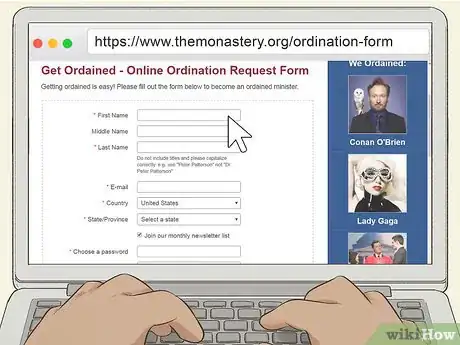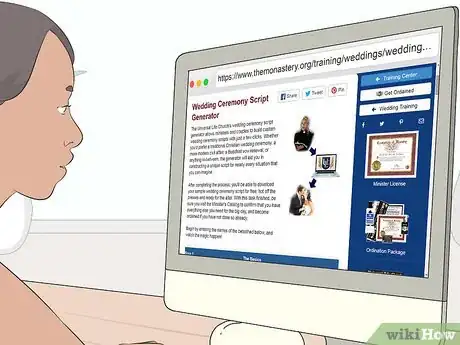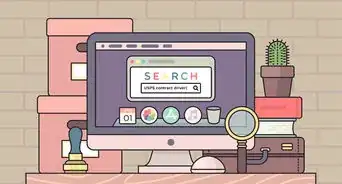This article was co-authored by wikiHow Staff. Our trained team of editors and researchers validate articles for accuracy and comprehensiveness. wikiHow's Content Management Team carefully monitors the work from our editorial staff to ensure that each article is backed by trusted research and meets our high quality standards.
This article has been viewed 99,251 times.
Learn more...
When it comes to becoming ordained in the UK, there are two main paths that people choose from. If you're hoping to officiate a friend or family member's wedding, you can get ordained online. However, unlike in some other countries, this unfortunately isn't legally binding in the UK—only leaders of the church and registrars have the power to officiate weddings legally. To become officially ordained as a priest, which takes many years, you can enroll in a theological institution and begin your training alongside your vicar. You can still officiate a wedding even if it isn't legally binding by having the couple visit a registry office to make their marriage official.
Steps
Getting Ordained Online
-
1Visit an online ordination page to begin the process. Go online to sites such as Universal Life Church or Open Ministry that have an online ordination option. Click on the button directing you to the page where you fill out your information. This button will often say something like, "Get Started" or "Begin Ordination Now."[1]
- It’s important to note that while you can go through the motions of becoming ordained online, it’s not legally binding in the UK.
- You can find Universal Life Church’s page at https://www.themonastery.org/wedding-laws/united-kingdom.
- Open Ministry can be found at https://www.oministry.com/.
-
2Submit the online ordination request form. When you click on the general ordination button to start the process, it will take you to a page where you’ll fill out your personal information. This includes things such as your name, email address, country, and password. Once you’re finished, click on the button at the bottom of the page to submit the request.
- The direct link for the ordination request form is https://www.themonastery.org/ordination-form, while Open Ministry's form can be found at https://www.oministry.com/get-ordained/.
- You need to be at least 18 years old to become ordained.
- Some ordination sites will require a fee once you submit the form, but others just ask for donations.
Advertisement -
3Wait for an email providing you with necessary information. After you submit the form, you’ll receive an email that tells you more about your ordination, such as the ordination date and links to necessary information. Once you get the email, your ordination has been processed.[2]
- This email acts as your receipt for your ordination.
- You may need to check your spam folder to find the email.
-
4Purchase documentation for the wedding. Most ordination sites will recommend that you get one of their ordination packages, including things like an ordination credential and certificates. Remember that since your ordination isn't legally binding, the couple that's getting married will need to make their marriage legal through other means.[3]
- Some ordination sites require you to purchase a package through their website, while others don't.
- You can find the link to Universal Life Church's Ordination Package at https://www.themonastery.org/catalog/ordinationpackage-p-129.html.
- Open Ministry's packages can be found at https://www.oministry.com/packages/.
-
5Use the site’s different tools to help you prepare for the wedding. The ordination website has links to useful pages you can use, such as the wedding ceremony script generator or a guide for how to perform a wedding ceremony. Read through the site’s information to prepare you to officiate the wedding.
- You can find the ceremony guide at https://www.themonastery.org/training/weddings/performing-a-wedding-3-steps.
- The wedding ceremony script generator helps you design the script you’ll use at the wedding, including things like the welcome statement, wedding sermon, and exchange of vows.
- Use the wedding ceremony script generator at https://www.themonastery.org/training/weddings/wedding-ceremony-script.
Becoming Officially Ordained Through the Church
-
1Talk to your chaplain or vicar to discuss your future path. If you’ve already become close with one of the leaders of your church, sit down with them to talk about your desire to become ordained. They’ll be able to help you choose the right path and answer any questions you might have about the process and length of time it takes.[4]
- They’ll be able to give you advice about what type of ministry would be best for you.
- If you’re not close with your chaplain, vicar, or other head of the church, visit a church and reach out to them in person, asking if you could talk to them for a few minutes about what it takes to become ordained.
- You might say something like, "I'm hoping to start on a path to ordination, and I'd really appreciate any advice you have for me."
-
2Choose a theological institution to start your education. The most common two types are residential and non-residential, meaning you live at the institution while studying, or you study away from the main campus most of the time. Decide which sort of training would be best for your lifestyle, and then do an online search to find the best options in your area.[5]
- For example, if you want to be fully immersed in your training and are able to leave your current house and lifestyle to do it, you might look for full-time residential trainings at theological institutions near you.
- Some theological institutions, like Trinity College Bristol, provide the option of doing your training part-time that's geared towards working people. Learning takes place just a couple evenings a week.
- If there aren’t many theological institutions near you, you may need to research non-residential options. Many have the choice to do part of your training online, meaning you would only need to commute for a portion of your learning.
-
3Complete your education by participating in your training. Your theological training will include things like participating in seminars, helping lead your local congregation, practicing spiritual discipline, and reflecting on the Bible. You’ll be expected to take your learning seriously, whether you’re learning on campus, off-campus, or online.[6]
- Be aware that this could take roughly three years if you're studying part time, while a full-time student could finish in about half that time.
-
4Become ordained by a bishop to start your curacy. After you’ve finished your education at a theological institution, you’ll be ordained as a deacon by your bishop. You’ll work with the vicar to help serve the people by holding religious services like weekly worships and offering assistance or guidance to the members of the congregation. This helps you to practice the things you’ve learned through your education and gain real experience.[7]
- For reference, a deacon is one step below a priest.
- Think of this time as a shadowing period where you learn as much from the vicar as possible.
- The time commitment will depend on the specific parish in which you're serving and how involved the vicar wants you to be.
-
5Spend a year working with your vicar before becoming a priest. Once you’ve gained experience and knowledge through your curacy in a parish, your bishop will likely make you an ordained priest. While you’ll now be an official priest, you’ll continue going through training to learn and practice more before starting your own post at a different church.[8]
- Once you’re a priest, you’ll be able to do weddings and baptisms.
- It should take you roughly a year after starting your curacy as a deacon before becoming a priest, depending on the specific sort of ministry you’ve chosen.
References
- ↑ https://www.themonastery.org/wedding-laws/united-kingdom
- ↑ https://www.themonastery.org/ordination-form
- ↑ https://www.themonastery.org/wedding-laws/united-kingdom
- ↑ https://www.churchofengland.org/life-events/vocations/preparing-ordained-ministry/understanding-selection
- ↑ https://www.trinitycollegebristol.ac.uk/kingdom-leading/ordination-training/
- ↑ https://www.churchofengland.org/life-events/vocations/preparing-ordained-ministry
- ↑ https://www.churchofengland.org/life-events/vocations/preparing-ordained-ministry
- ↑ https://www.churchofengland.org/life-events/vocations/preparing-ordained-ministry










-Step-9.webp)




















-Step-9.webp)





































